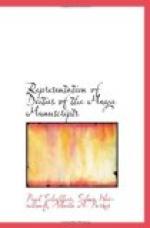It should be mentioned that God M is represented as a rule as an old man with toothless jaw or the characteristic solitary tooth. That he is also related to bee-culture is shown by his presence on p. 4*c of the Codex Troano, in the section on bees.
Besides gods L and M, a few quite isolated black figures occur in the Codex Troano, who, apparently, are identical with neither of these two deities, but are evidently of slight importance and perhaps are only variants of other deities. Similar figures of black deities are found in the Codex Tro. 23, 24 and 25 (perhaps this is a black variant of B as god of the storm?) and on 21*c we twice see a black form with the aged face and the solitary tooth in the under jaw (perhaps only a variant of M). In the Codex Cortesianus and in the Dresden manuscript no other black deities occur, but in the Paris manuscript a black deity seems to be pictured once (p. 21, bottom).
According to Brinton (Nagualism, Philadelphia 1894, pp. 21, 39), there is among the Tzendals in addition to Ekchuah, a second black deity called Xicalahua, “black lord”.
N. The God of the End of the Year.
[Illustration: Figs. 49-51]
We have here a deity with the features of an old man and wearing a peculiar head ornament reproduced in Fig. 50, which contains the sign for the year of 360 days. The god’s hieroglyph is Fig. 49, which consists of the numeral 5 with the sign of the month Zac. Foerstemann has recognized in god N the god of the five Uayeyab days, which were added as intercalary days at the end of the original year of 360 days, and were considered unlucky days. N is, therefore, the god of the end of the year. Foerstemann has discussed him in detail under this title in a monograph published in Globus, Vol. 80, No. 12. It is still open to question whether god N actually occurs in all the places of the Dresden manuscript, which are mentioned by Foerstemann. He can be recognized positively on Dr. 17a, 21c (grouped with a woman) and 37a; also on 12c, but in this latter place with pronounced deviations from the usual representations. The figures in Dr. 23c (first group) and 43a (third picture) are doubtful, especially since the hieroglyph of the god is lacking in both instances. The third group in Dr. 21c is equally dubious. Here a woman is pictured sitting opposite a god. The latter seems to be god N, yet in the text we find instead of his sign the hieroglyph given in Fig. 51. It is not impossible that this sign likewise denotes god N.
God N is found a few times in the Paris manuscript, for example on p. 4, where he holds K’s head in his hands, and on p. 22.
O. A Goddess with the Features of an Old Woman.
[Illustration: Fig. 52]




